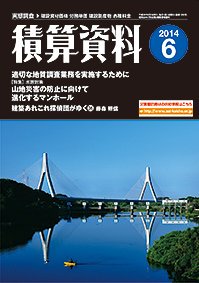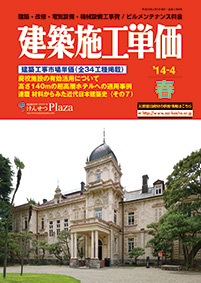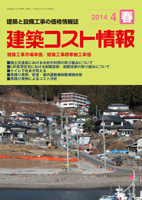First Published: April 2014
Revised: January 2022
Research Institute on Building Cost (RIBC)
- Objectives of the Public Announcement
- Overview of the Data
- Market unit price (MUP)
- Construction process unit price (CPUP)
- Material unit price
- Labor rates
※1 The market unit price (MUP), shijo-tanka in Japanese, refers to the price that was used in dealings between a general contractor and their primary subcontractor under full competition in the market. It is a traded unit price per execution unit, which includes costs of materials, labor, machinery, transportation, subcontracting, etc. (It does not include consumption tax.)
Objectives of the Public Announcement
When one wishes to study changes in market unit prices, unit material costs, and labor rates, i.e., components of building costs, there is unfortunately a scarcity of data that systematically and longitudinally follows those fluctuations. Therefore, RIBC has created this set of data and made it publicly available. A list of research articles on changes in these unit prices and costs is also included with the data.
Overview of the Data
This set of data organizes temporal changes and regional differences in unit prices and costs of representative components of building costs, with the aim to better understand the factors of fluctuation in building production costs.
This study follows the changes in unit execution prices (most of which are later replaced by market unit prices as deemed appropriate), unit material costs and labor rates from 2015 to the current. Unit execution prices are divided into three areas: building construction, electrical installation and mechanical installation. A total of 40 items were selected from these three areas: 18 items for building market unit price, 13 for electrical market unit price and 9 for mechanical market unit price. 8 items were recorded construction process unit price, 50 items under material unit price, and 19 items under labor rates.
The Research Institute on Building Cost (RIBC) assumes the full responsibility for the publication of this set of data, with the consent of both of the above-mentioned research agencies. Although data was recorded and processed with great care, we cannot guarantee that it is free of errors due to misreading or misunderstanding. It is also important that those who wish to use our data recognize the following facts:
The targets and criteria of the investigation often altered for each of the recorded items. It is therefore highly probable that such alterations may have had an effect, especially where significant price fluctuations occur in the graphs.
There are occasionally items for which only nation-wide unit prices or costs were given. In those cases, we present such data as being from one region in the graphs. (“Fluorescent lighting fixture” under unit material costs is an example of one such item.)
Dates indicated in the graphs and tables come from the dates of issue of the publications used for the study. Therefore, the dates given may differ slightly from when the data was actually generated.
Index of the published items
- 1-1.Building market unit price (18 items)
- 1-2.Electrical market unit price (13 items)
- 1-3.Mechanical market unit price (9 items)
- 3-1.Building material unit price (21 items)
- 3-2.Electrical material unit price (19 items)
- 3-3.Mechanical material unit price (10 items)
- 4-1.Building labor rates (15 items)
- 4-2.Electrical labor rates (1 items)
- 4-3.Mechanical labor rates (3 items)
Some materials must be downloaded as PDF files, and require Adobe Reader to view or print them.
1.Market unit price (MUP) (40 items)
Most of the construction process unit price that we investigated were replaced with “market unit price (MUP)” at different times during the study as deemed appropriate. A market unit price refers to a unit execution price that includes both materials and labor. What should be included in market unit prices was strictly defined and investigated. (Please refer to Reference 3 below.) Prior to the change to market unit prices, the two research agencies independently investigated and recorded unit execution prices. In cases where those agencies' publications continue to record unit execution prices even after they were replaced by market unit prices, we did not use that data. Instead, we report market unit prices. Also included in our study are a few items, which have not yet been changed to market unit prices.
1-1.Building market unit price
1-2.Electrical market unit price
1-3.Mechanical market unit price
2.Construction process unit price (CPUP) (8 items)
3.Material unit price (50 items)
We selected 50 items, which are key materials in building construction.
3-1.Building material unit price
3-2.Electrical material unit price
3-3.Mechanical material unit price
4.Labor rates (19 items)
Labor rates for 11 principal occupations were taken from the Labor Rates of Wages for Public Works Estimate (LRWPWE)※2, published since 1997 by the Ministry of Construction (currently called the Ministry of Land, Infrastructure, Transport and Tourism (MLIT)). Prior to 1997, we used data published independently by the two research agencies, based on the Studies of Labor Rates for Public Works. It must be noted here that there are significant differences in ways data is surveyed and published in the Labor Rates Surveyed (prior to 1996) and in the Labor Rates of Wages for Public Works Estimate (LRWPWE) (since 1997). Furthermore, data on certain occupations (electrician, plumber, and interior finisher) was not published for the years 1997 and 1998 in the LRWPWE.
※2 Labor rates without fringe benefits
(Construction Market Division, Land Economy and Construction and Engineering Industry Bureau, MLIT)




